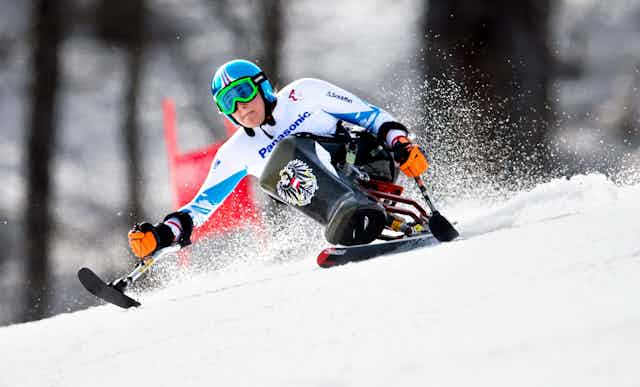Athletes competing at the Paralympic Winter Games in Sochi have varying levels of access to science, medicine, technology and engineering support from their national sporting organisations.
As with the Winter Olympics held earlier this year, some athletes benefit from a very comprehensive, bespoke service to support their performance. This kind of service raises important issues about whether technology and engineering innovations are “essential for performance” or constitute “performance enhancement”.
How do blind biathletes shoot targets?
Some technological and engineering advances can be accessed by all athletes at the Winter Paralympics. All visually impaired competitors in the Biathlon events have access to optronic rifles that are sensory substitution devices.
Athletes arrive at their prone shooting position with their rifles connected to the targets. Their sight of the target is replaced by augmented sound. Athletes wear electro-acoustic headphones that relay different tones depending on where the athlete aims the rifle at a 25mm diameter target 10m away.
As the rifle moves to the centre of the target the tone becomes higher. There is a camera in the rifle that detects a LED light at the centre of the target. Once the athlete has pulled the trigger on the rifle, she or he can hear whether they have hit the target from the tone they hear.
This sensory substation gives visually impaired athletes the essential support they need for performance. In Biathlon, athletes are required to ski a penalty loop or receive a time penalty for each missed shot.
Local investment
Many of the nations at the Winter Paralympics have made significant investments in developing services to their athletes that go beyond shared facilities. The UK has had a decade of working closely with industry and universities to test methods and equipment that might yield performance gains.
Last year, the Australian Sports Commission (ASC) formed a two-year partnership with the Australian Sports Technologies Network in order to support innovative use of technology and engineering.
While the announcements about such partnerships are made public, there is usually a silence about what the partnerships are doing to improve performance. Many countries believe that the silence protects their “competitive advantage”. Occasionally, some information is shared.
Personal engineering
New Zealander Adam Hall is an Alpine Skiing competitor at Sochi classified as LW1 (an athlete with an impairment that strongly affects both legs). He won the standing slalom gold medal in Vancouver in 2010.

In the intervening four years Adam has undergone detailed physical evaluations to explore any adaptations that might be possible to improve his performance.
Two distinct areas were identified during these evaluations:
- one was to transform the ankle foot orthoses worn by him in order to optimise his racing position. Adam was scanned in 3D to model the biomechanical alignment of his lower limbs. The company that undertook this project in New Zealand has worked with NASA on the Mars exploration project
- a second area for improved design and fabrication was Adam’s outriggers (elbow skis). These carbon fibre outriggers were produced by a company with a record of involvement in New Zealand’s America’s cup teams.
Another example of the use of innovative design engineering comes from Canada. Work has been underway since the Vancouver Games to develop a sit-ski sled that optimises performance and safety.
The designer, Joe Franklin, has been investigating the properties of shock absorbers and has chosen to use mountain bike shock absorbers and a lightweight frame design to make the sleds much more responsive to the terrain.
One of the athletes using the new sled, Josh Dueck, won a silver medal in the Men’s Downhill – Sitting event.

A second athlete, Caleb Brousseau, won a bronze medal in the Men’s Super G – Sitting event.
Whilst these are shared examples of innovation in design and engineering, much of the innovation at Sochi remains unshared. It is highly likely that many of the equipment learning experiences at the Winter Olympics a month ago will be embedded in Paralympic programs.
The adoption of innovation brings the question of “performance enhancement” to the fore. The International Paralympic Committee (IPC) mandates that
In principle unnatural or artificial aids which modify the performance of the competitors and/or constitute a technical correction of the individual’s physical predisposition to a defective performance, as well as competition equipment which impact the health of the competitors or increase the risk of accidents are to be excluded.
The availability of an ASC Competitive Innovation Fund will focus the ethical dimensions of this debate in Australia.
Each year the fund will seek applications for
Technology related activities that are innovative, are able to demonstrate a positive performance impact and which may be ‘outside’ the scope of existing resources.
So in South Korea in 2018, who knows what incredible technology we’ll see?

